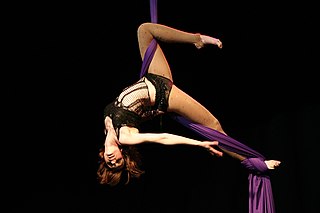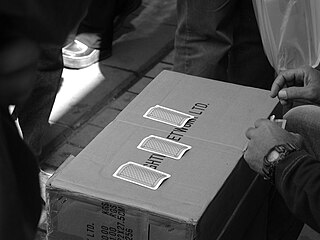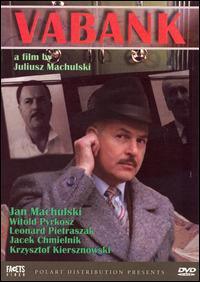Related Research Articles

Roulette is a casino game named after the French word meaning little wheel. In the game, players may choose to place bets on either a single number, various groupings of numbers, the colors red or black, whether the number is odd or even, or if the numbers are high (19–36) or low (1–18).
Tubes and primers are used to ignite the propellant in projectile weapons.

A cartridge or a round is a type of pre-assembled firearm ammunition packaging a projectile, a propellant substance and an ignition device (primer) within a metallic, paper or plastic case that is precisely made to fit within the barrel chamber of a breechloading gun, for the practical purpose of convenient transportation and handling during shooting. Although in popular usage the term "bullet" is often used to refer to a complete cartridge, it is correctly used only to refer to the projectile.

A confidence trick is an attempt to defraud a person or group after first gaining their trust. Confidence tricks exploit victims using their credulity, naïveté, compassion, vanity, irresponsibility, and greed. Researchers have defined confidence tricks as "a distinctive species of fraudulent conduct ... intending to further voluntary exchanges that are not mutually beneficial", as they "benefit con operators at the expense of their victims ".

Flintlock is a general term for any firearm that uses a flint striking ignition mechanism. The term may also apply to a particular form of the mechanism itself, also known as the true flintlock, that was introduced in the early 17th century, and rapidly replaced earlier firearm-ignition technologies, such as the matchlock, the wheellock, and the earlier flintlock mechanisms.
A crusher is a machine designed to reduce large rocks into smaller rocks, gravel, sand or rock dust.

The shell game is portrayed as a gambling game, but in reality, when a wager for money is made, it is almost always a confidence trick used to perpetrate fraud. In confidence trick slang, this swindle is referred to as a short-con because it is quick and easy to pull off. The shell game is related to the cups and balls conjuring trick, which is performed purely for entertainment purposes without any purported gambling element.

A rifled breech loader (RBL) is an artillery piece which, unlike the smoothbore cannon and rifled muzzle loader (RML) which preceded it, has rifling in the barrel and is loaded from the breech at the rear of the gun.
In the field of firearms and airguns, obturation denotes necessary barrel blockage or fit by a deformed soft projectile. A bullet or pellet, made of soft material and often with a concave base, will flare under the heat and pressure of firing, filling the bore and engaging the barrel's rifling. The mechanism by which an undersized soft-metal projectile enlarges to fill the barrel is, for hollow-base bullets, expansion from gas pressure within the base cavity and, for solid-base bullets, "upsetting"—the combined shortening and thickening that occurs when a malleable metal object is struck forcibly at one end.
Tipp-Ex is a brand of correction fluid and other related products that is popular throughout Europe. It was also the name of the German company that produced the products in the Tipp-Ex line. While Tipp-Ex is a trademark name for correction products, in some countries it has become a genericised trademark: to tippex or to tippex out means to erase, either generally or with correction fluid.
The drop swindle was a confidence trick commonly used during the 19th and 20th centuries. Employing a variety of techniques the con usually consists of the "dropper", who purposely drops a wallet containing counterfeit money near a potential victim. As the victim goes to pick it up the "dropper" turns to pick it up at the same moment pretending to have found the wallet as well. Acting as if he is in a hurry the "dropper" offers to give the wallet to the victim in exchange for money while the victim can claim the reward from the owner. One of the leading practitioners of this confidence trick was "Kid Dropper" Nathan Kaplan, an early twentieth century gangster.

The Disappearing Floor is Volume 19 in the original The Hardy Boys Mystery Stories published by Grosset & Dunlap.

The Colt Army Model 1860 is a cap & ball .44-caliber single-action revolver used during the American Civil War made by Colt's Manufacturing Company. It was used as a side arm by cavalry, infantry, artillery troops, and naval forces.

Aerial silks is a type of performance in which one or more artists perform aerial acrobatics while hanging from a fabric. The fabric may be hung as two pieces, or a single piece, folded to make a loop, classified as hammock silks. Performers climb the suspended fabric without the use of safety lines and rely only on their training and skill to ensure safety. They use the fabric to wrap, suspend, drop, swing, and spiral their bodies into and out of various positions. Aerial silks may be used to fly through the air, striking poses and figures while flying. Some performers use dried or spray rosin on their hands and feet to increase the friction and grip on the fabric.

Three-card Monte – also known as Find the Lady and Three-card Trick – is a confidence game in which the victims, or "marks", are tricked into betting a sum of money, on the assumption that they can find the "money card" among three face-down playing cards. It is very similar to the shell game except that cards are used instead of shells.

Penn & Teller's Cruel Tricks for Dear Friends is a 1987 direct-to-video program hosted by magicians Penn & Teller. Produced by The Mofo Video Corp. and released by Lorimar Home Video, the tape features seven different swindles or tricks that the home viewer can use to fool their friends. The tape was a companion piece to their best-selling book of the same name, released two years later. All of the tricks involve using a portion of the videotape.

Vabank is a 1981 Polish comedy heist film written and directed by Juliusz Machulski, set in 1934 Warsaw.

A paper cartridge is one of various types of small arms ammunition used before the advent of the metallic cartridge. These cartridges consisted of a paper cylinder or cone containing the bullet, gunpowder, and in some cases, a primer or a lubricating and anti-fouling agent. Combustible cartridges are paper cartridges that use paper treated with oxidizers to allow them to burn completely upon ignition.

Derren Brown: The Events is a Channel 4 television series featuring the illusionist Derren Brown. Filmed in front of a live studio audience, this series is made up of four one-hour specials, during which Brown attempted what he had described as "some of the most incredible feats to date". The series consisted of a mixture of pre-recorded location pieces connected by theatre-based segments, with each of the four programmes building up to a major stunt performance.
References
- 1 2 McCabe, James (1868). The Secrets of the Great City. National publishing Company. pp. 535–536. ISBN 9780608411484.
- ↑ "Showing 18 results for: 'patent-safe'". The New York Times .